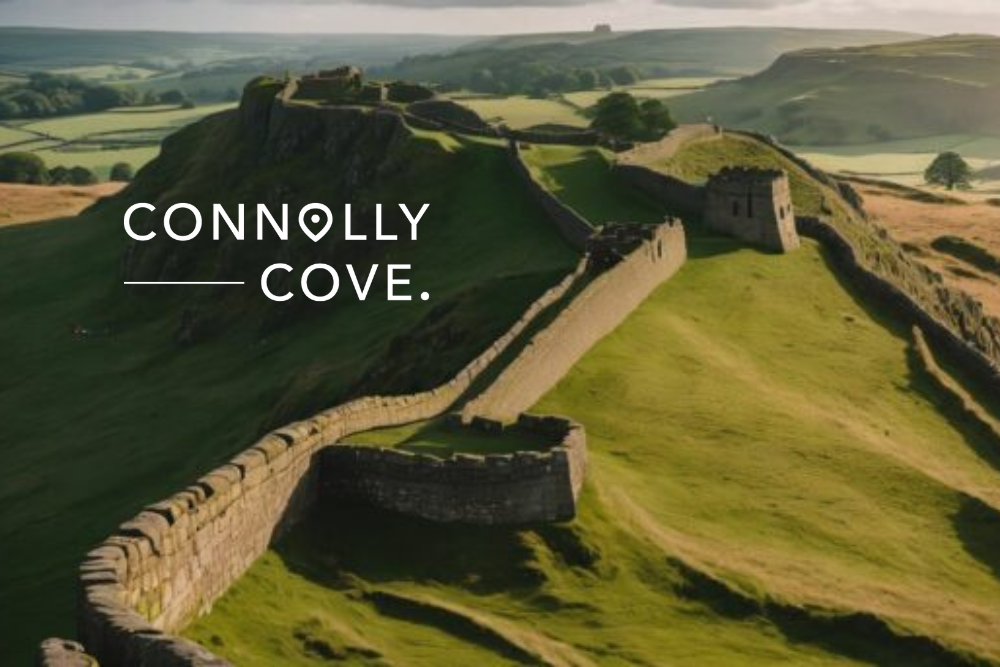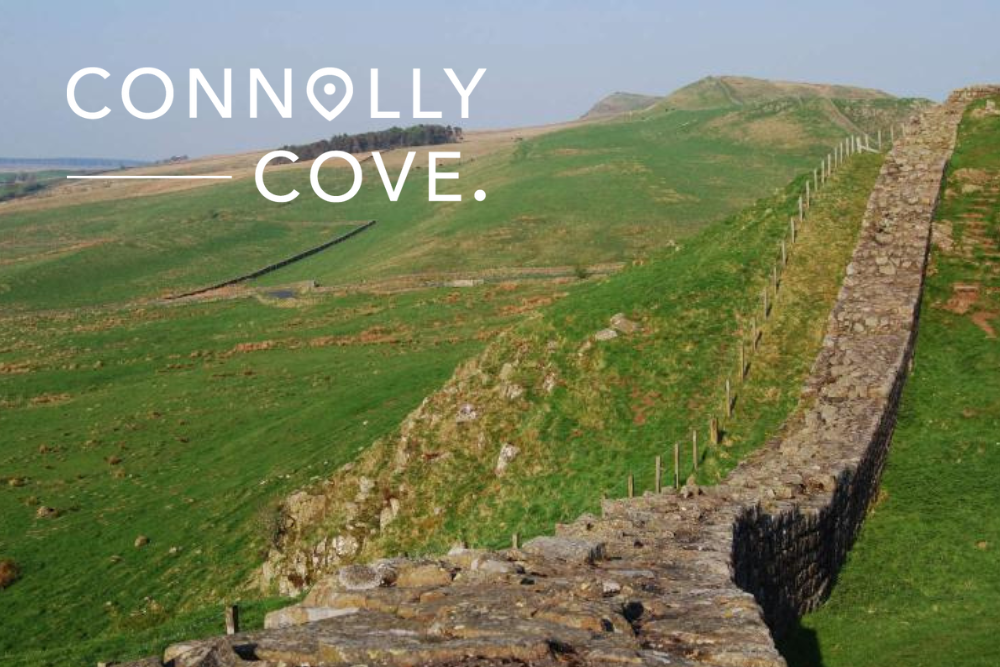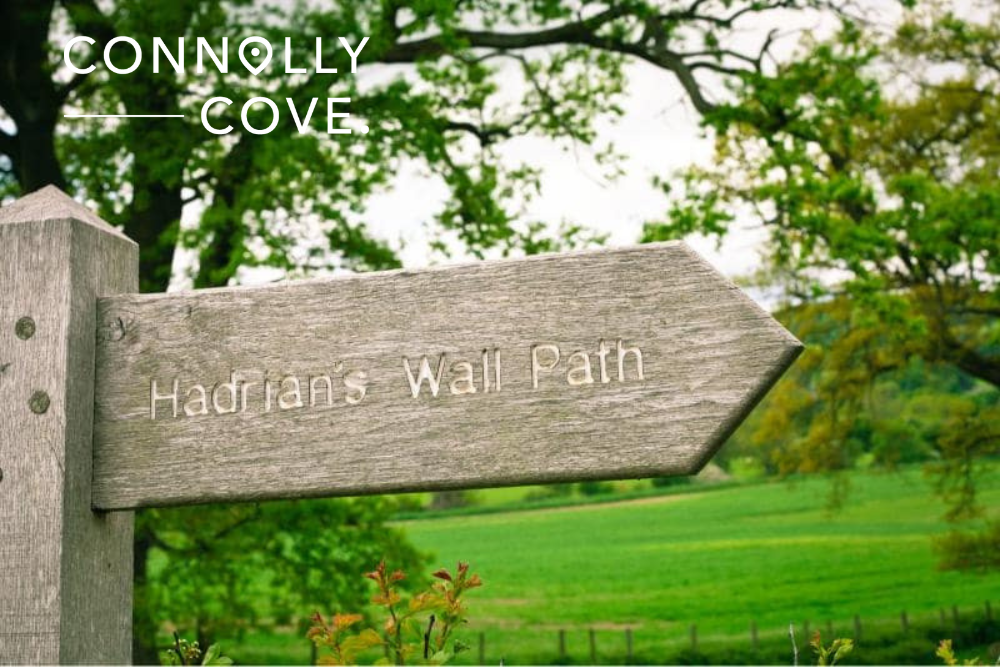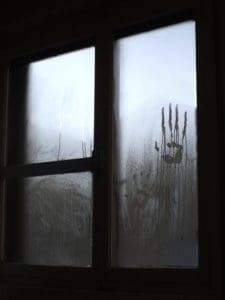Hadrian’s Wall: A Historic Barrier Between Roman Britannia and Caledonia

Updated On: February 05, 2024 by Fatma Mohamed
Hadrian’s Wall, a monumental testament to ancient engineering and military prowess, stands as a defining barrier between the realms of Roman Britannia and the enigmatic land of Caledonia. This colossal structure, commissioned by Emperor Hadrian in the 2nd century AD, not only served as a physical divide but also symbolised the cultural and geopolitical distinctions of its time.
In this article, we unravel the secrets of Hadrian’s Wall, peering into its historical significance, architectural marvels, and the narratives etched into its stones, revealing the intriguing story of a boundary that once shaped the destiny of two civilisations. So, join us on a journey through time as we delve into the compelling history behind Hadrian’s Wall.
Table of Contents
History and Construction of Hadrian’s Wall
Imagine a colossal stone serpent snaking across a windswept landscape, marking the edge of an empire. That’s Hadrian’s Wall, a 73-mile testament to Roman ambition and engineering prowess that once demarcated the northern frontier of their vast domain.
Built in 122 AD, Hadrian’s Wall is a Roman marvel, earning World Heritage status in 1987. This best-preserved Roman frontier conquered harsh landscapes, from raging rivers to rocky hills. As Britain’s most impressive Roman monument, it joins the Antonine Wall and Upper German Limes as part of a UNESCO World Heritage Site.

Reasons Behind the Construction of Hadrian’s Wall
In 122 AD, Emperor Hadrian visited Britain and declared, “Build a wall!” His biographer, writing 200 years later, claimed it stretched “73 miles from sea to sea to separate the Romans from the barbarians.” But was that its only purpose?
Frontier Control: Like modern borders, Hadrian’s Wall aimed to regulate movement. The Roman army enforced rules on who could enter and how. Think checkpoints, travel permits, and designated entry points. This helped prevent unwanted crossings and raids, a common occurrence on Roman frontiers.
Defence or More? While auxiliary units stationed along the Wall provided military defence, some argue the Wall’s placement wasn’t ideal for pure defence. This suggests other roles, like:
- Patrolling: Cavalry stationed at forts likely ventured north, scouting and keeping an eye on potential threats.
- Diplomacy: Evidence suggests that later Romans interacted with their northern neighbours through scouting missions and treaties.
Dimensions and Route
Hadrian’s Wall is an impressive defensive barrier that stretches across the northwest frontier of Roman Britain. It spanned a distance of 73 miles, going from Newcastle to the Solway Firth on the Irish Sea.
The marvellous Wall was about 10 feet wide and stood at a height of approximately 15-20 feet. It was built using locally sourced stone and had forts placed along its length to house soldiers. The materials varied depending on the terrain, from stone and turf in the east to imposing sandstone walls in the west.
The route of Hadrian’s Wall was carefully chosen to create a clear boundary between Roman Britannia and Caledonia. It followed a strategic path, traversing rugged terrain and natural obstacles such as rivers and hills.
Construction Techniques
When building Hadrian’s Wall, the Roman Empire used two different construction techniques: the “Broad Wall” and the “Narrow Wall.” The Broad Wall was built with a wide base and narrower top, making it stronger and more resistant to attacks.
On the other hand, the Narrow Wall had a thinner base but was taller, allowing for better visibility of approaching enemies. These construction techniques were crucial in creating a formidable defensive barrier that would deter invaders from entering Roman Britannia.
In summary, Hadrian’s Wall showcased a combination of construction techniques, including the broad and narrow wall approaches, contributing to the Wall’s formidable strength and historical significance.
The Vallum and Turf Wall
The Vallum and turf wall were additional features of Hadrian’s Wall. A large ditch ran parallel to the Wall, separating it from the military road and providing extra defence.
The turf wall, built on top of the initial stone structure, acted as an alternative barrier in certain sections. These unique elements of Hadrian’s Wall demonstrate the engineering ingenuity and strategic planning involved in its construction.
North and South of the Wall
On the northern side of Hadrian’s Wall, beyond the boundary of Roman Britannia, lies an unconquered land known as Caledonia. This rugged region, now modern-day Scotland, was home to fierce tribes that resisted Roman rule.
Within Roman Britannia, bustling settlements and military garrisons lay on the southern side of the Wall. Merchants and civilians thrived in this prosperous province while soldiers maintained order and defended against potential invaders.
As we stand here at Hadrian’s Wall today, we can imagine what life was like on both sides all those centuries ago. To the north, beyond these ancient stones, stretched untamed wilderness and brave warriors defending their independence. On the other side, to the South lay a vibrant society influenced by Roman culture — a hub of trade, commerce, and innovation.
Preservation and Recognition of Hadrian’s Wall
Hadrian’s Wall has not only been preserved over the years but also gained recognition as a World Heritage Site, attracting tourists and inspiring fictional representations in popular culture.

Preservation Efforts by John Clayton
John Clayton (1792-1890) served as the town clerk of Newcastle upon Tyne, and he was not only a lawyer but also an antiquarian. Despite the significance of his efforts in excavating and safeguarding Hadrian’s Wall, his contributions have frequently been underestimated. It is crucial to recognise that, without Clayton, a substantial portion of this internationally recognised World Heritage Site might have been at risk of loss.
Thanks to his work, many sections of the Wall were saved from destruction. His efforts also led to the discovery of additional sites in the area related to Roman history.
Today, visitors can explore this historic landmark and learn about its significance, thanks mainly to John Clayton’s dedication and passion for preserving history.
Discovery of Additional Sites
During the preservation efforts of Hadrian’s Wall, several additional sites were discovered, adding to the rich history of this ancient barrier. These new findings include Roman forts, mile castles, and turrets, providing a deeper understanding of the Wall’s construction and purpose.
Exploring these sites allows you to see first-hand how soldiers and civilians lived along the frontier. It also offers a glimpse into the challenges they faced from Caledonian tribes and other barbarian invaders.
The discovery of these additional sites adds even more intrigue and fascination to an already captivating destination for history buffs and nature lovers.
Designation as a World Heritage Site
Hadrian’s Wall has been recognised as a World Heritage Site, showcasing its historical and cultural significance. As one of Britain’s most remarkable landmarks, the Wall attracts visitors from all over the world. Its designation as a World Heritage Site highlights its importance in understanding Roman history and architecture.
The preservation of Hadrian’s Wall is crucial to maintaining its integrity as a cultural heritage site. Efforts have been made to conserve and protect this ancient monument for future generations.
It also provides insights into Roman military strategies and their occupation of Britain. With its thrilling views of the surrounding countryside, Hadrian’s Wall attracts tourists who appreciate both historical significance and natural beauty.
Fictional Representations in Popular Culture
Hadrian’s Wall has captured the imagination of many writers and filmmakers, leading to its portrayal in popular culture. In novels like “The Eagle of the Ninth” by Rosemary Sutcliff and movies like “Centurion,” the Wall serves as a dramatic backdrop for thrilling tales set during Roman times.
Its majestic structure and historical significance make it an attractive setting for both fictional stories and historical dramas. These representations help bring the history of Hadrian’s Wall to life, allowing us to envision this ancient historical barrier between Roman Britannia and Caledonia.
Immersing Yourself in History: 3 Must-See Sites Near Hadrian’s Wall
Hadrian’s Wall stretches across England’s north, whispering tales of Roman ambition and resilience. But to truly grasp its grandeur, venture beyond the Wall itself and explore nearby sites teeming with history. Here are three must-sees that will transport you back in time. Don’t miss to visit them during your exploration of Hadrian’s Wall.
1. Housesteads Roman Fort
Imagine towering stone walls enclosing a bustling Roman community; Housesteads Roman Fort is a remarkably well-preserved Roman fort perched atop a dramatic escarpment on Hadrian’s Wall in Northumberland, England. It stands as one of the most complete and extensively displayed forts along the entire Wall, offering a captivating glimpse into Roman military life and frontier defence nearly 2,000 years ago. Climb the commanding walls for breathtaking panoramic views and feel the weight of history beneath your feet.
2. Vindolanda
Vindolanda, nestled near Hadrian’s Wall in Northumberland, England, is more than just a Roman fort. It’s a unique archaeological site that unlocks a treasure trove of knowledge about daily life on the Roman frontier nearly 2,000 years ago.
Unlike many Roman forts primarily showcasing military aspects, Vindolanda offers a unique window into civilian life. Its claim to fame lies in the remarkable discovery of over 1,000 wooden writing tablets preserved in the anaerobic boggy ground.
These “Vindolanda tablets,” written in ink, offer unprecedented insights into everyday experiences and social interactions on the frontier. Imagine deciphering personal letters, shopping lists, military orders, and even birthday invitations, bringing the past to life with startling immediacy.
3. Chesters Roman Fort
Chesters Roman Fort, also known as Cilurnum, stands guard along Hadrian’s Wall in Chollerford, England. Built around 124 AD, Chesters served as a vital cavalry fort, housing approximately 500 horse riders who patrolled the northern frontier. Unlike other forts, heavily focused on infantry, Chesters held significance due to its mounted troops, offering a glimpse into a specialised aspect of Roman military life.
Visitors can wander through the partially restored remains of the fort and imagine the hustle and bustle of Roman activity. Whether you’re interested in Roman cavalry tactics, architectural details, or simply soaking in the historical atmosphere, Chesters offers a unique and rewarding experience.
Amazingly, dear reader, these are just a taste of the treasures that await near Hadrian’s Wall. Each site unveils a unique facet of Roman life, inviting you to explore, imagine, and connect with the echoes of the past. So, embark on your own historical adventure and discover the captivating stories waiting to be unearthed near this iconic landmark.
Last Words
Hadrian’s Wall may mark the end of the Roman Empire in Britain, but its story is far from over. Each new discovery, each whispered tale, adds another layer to its fascinating narrative. What secrets will it reveal next? What echoes of the past will resonate in the years to come? The answers lie waiting, just beyond the stones, inviting you to explore this captivating monument to ambition and history.






